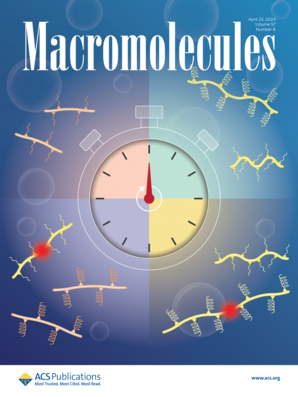Thermo-Mechanics of PNIPAM Gels: from a Single Chain to a Network Response
IF 5.1
1区 化学
Q1 POLYMER SCIENCE
引用次数: 0
Abstract
Poly(N-isopropylacrylamide) (PNIPAM) is a temperature-responsive polymer that exhibits a lower critical solution temperature (LCST) phase transition. On the chain level, this behavior stems from a coil-to-globule configurational transition at a critical temperature. On the macroscopic level, copolymerization or cross-linking of PNIPAM results in a hydrogel that decreases its volume significantly at the volume phase transition temperature (VPTT). This behavior is advantageous in a wide range of applications, including tissue engineering, drug delivery systems, and soft robotics. To fully exploit the unique properties of PNIPAM, it is important to understand the underlying mechanisms that govern its thermo-mechanical response. In this work we present a microscopically motivated energy-based model to explain the coil-to-globule transition in PNIPAM networks. We begin by considering a single chain below and above the LCST and employ tools from polymer physics to capture the water–polymer interactions and the role of water cages on the entropy. We present physically motivated parameters to describe the transition of a PNIPAM chain in response to temperature and an external force and validate our model against nanofishing experiments on single PNIPAM chains. To determine the macroscopic response, we employ the chain model and integrate from the chain to the network level. Our model illustrates the influence of the coil-to-globule transition on the decrease in volume of a PNIPAM gel as the temperature increases. As opposed to the classical approaches, in which the interaction parameter χ is taken as a function of temperature, the proposed model captures the transition at the chain level, which directly affects the macroscopic response. To demonstrate the merit of the model, we compare its predictions to experimental data on the volumetric deformations and the stress of traction free and of constrained PNIPAM networks. The findings from this work provide valuable insights into the molecular mechanisms that dominate the response of PNIPAM gels and provide fundamental tools for the design and optimization of PNIPAM-based gels for various applications.

PNIPAM凝胶的热力学:从单链到网络响应
聚n -异丙基丙烯酰胺(PNIPAM)是一种温度响应聚合物,具有较低的临界溶液温度(LCST)相变。在链的层面上,这种行为源于临界温度下线圈到球的构型转变。在宏观层面上,PNIPAM的共聚或交联导致水凝胶在体积相变温度(VPTT)下体积显著减小。这种行为在广泛的应用中是有利的,包括组织工程,药物输送系统和软机器人。为了充分利用PNIPAM的独特性能,了解控制其热机械响应的潜在机制是很重要的。在这项工作中,我们提出了一个微观驱动的基于能量的模型来解释PNIPAM网络中线圈到球体的转变。我们首先考虑LCST上下的单链,并使用聚合物物理学的工具来捕获水-聚合物相互作用和水笼对熵的作用。我们提出了物理动机参数来描述PNIPAM链对温度和外力响应的转变,并通过单个PNIPAM链的纳米钓鱼化实验验证了我们的模型。为了确定宏观响应,我们采用链条模型,从链条到网络层面进行整合。我们的模型说明了随着温度的升高,线圈到球体的转变对PNIPAM凝胶体积减小的影响。与将相互作用参数χ作为温度的函数的经典方法相反,该模型捕获了直接影响宏观响应的链级转变。为了证明该模型的优点,我们将其预测与无牵引和约束PNIPAM网络的体积变形和应力的实验数据进行了比较。这项工作的发现为PNIPAM凝胶反应的分子机制提供了有价值的见解,并为各种应用的PNIPAM凝胶的设计和优化提供了基本工具。
本文章由计算机程序翻译,如有差异,请以英文原文为准。
求助全文
约1分钟内获得全文
求助全文
来源期刊

Macromolecules
工程技术-高分子科学
CiteScore
9.30
自引率
16.40%
发文量
942
审稿时长
2 months
期刊介绍:
Macromolecules publishes original, fundamental, and impactful research on all aspects of polymer science. Topics of interest include synthesis (e.g., controlled polymerizations, polymerization catalysis, post polymerization modification, new monomer structures and polymer architectures, and polymerization mechanisms/kinetics analysis); phase behavior, thermodynamics, dynamic, and ordering/disordering phenomena (e.g., self-assembly, gelation, crystallization, solution/melt/solid-state characteristics); structure and properties (e.g., mechanical and rheological properties, surface/interfacial characteristics, electronic and transport properties); new state of the art characterization (e.g., spectroscopy, scattering, microscopy, rheology), simulation (e.g., Monte Carlo, molecular dynamics, multi-scale/coarse-grained modeling), and theoretical methods. Renewable/sustainable polymers, polymer networks, responsive polymers, electro-, magneto- and opto-active macromolecules, inorganic polymers, charge-transporting polymers (ion-containing, semiconducting, and conducting), nanostructured polymers, and polymer composites are also of interest. Typical papers published in Macromolecules showcase important and innovative concepts, experimental methods/observations, and theoretical/computational approaches that demonstrate a fundamental advance in the understanding of polymers.
 求助内容:
求助内容: 应助结果提醒方式:
应助结果提醒方式:


